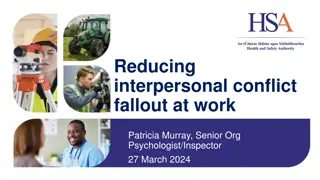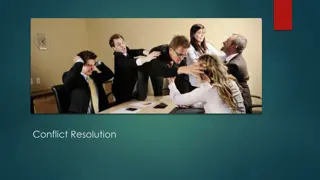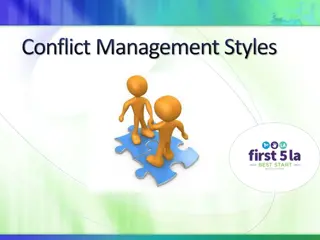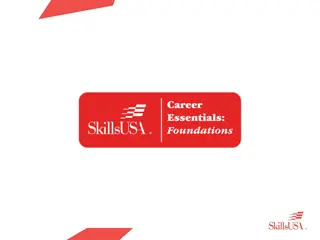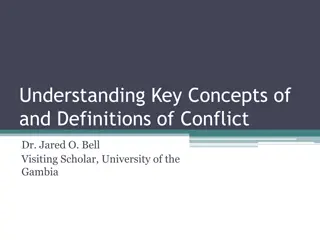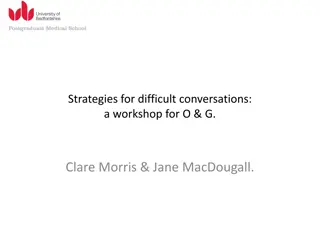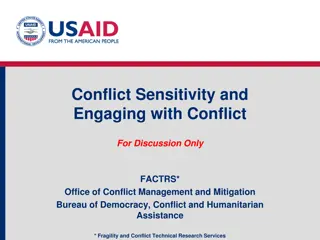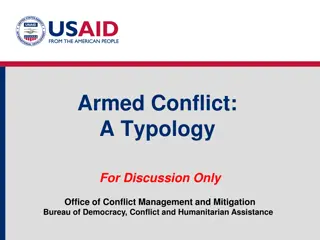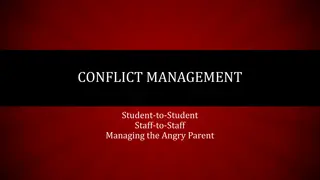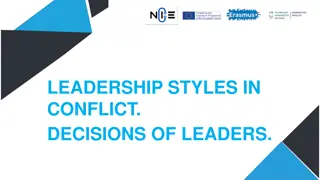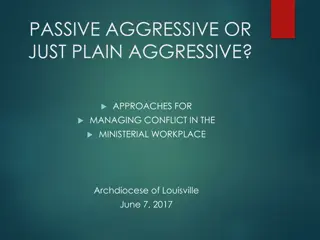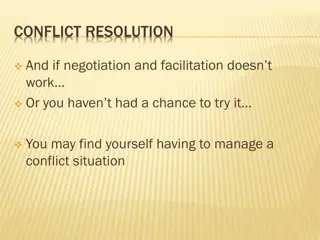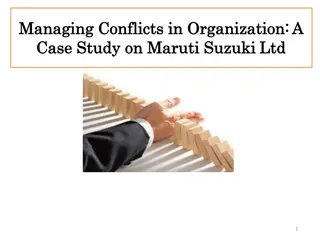Understanding Conflict Management: Key Perspectives and Approaches
Explore the multifaceted realm of conflict management through the lenses of traditional, humanistic, and interactionistic views. Delve into the definition, nature, and implications of conflict, and assess varying opinions on confrontation, communication, and resolution strategies within organizations. Gain insights on the role of conflict in group dynamics and leadership, reflecting on the constructive potential amidst differing perspectives.
- Conflict management
- Perspectives
- Organizational conflict
- Communication strategies
- Leadership dynamics
Download Presentation

Please find below an Image/Link to download the presentation.
The content on the website is provided AS IS for your information and personal use only. It may not be sold, licensed, or shared on other websites without obtaining consent from the author. Download presentation by click this link. If you encounter any issues during the download, it is possible that the publisher has removed the file from their server.
E N D
Presentation Transcript
Conflict Management Pratibha Dhungana and Shailendra Prasad Bhatt
Definition of conflict Negative ??? Harmful ???
Agenda Understanding conflict Conflicting Process Conflict Management: What? Why and, How? Conclusion
Forethought A good manager does not want to eliminate conflict. He tries to keep it from wasting the energies of his people. If you are the boss and your people fight openly when they think that you are wrong- that s healthy. - Robert Townsend
Do you agree/disagree ? 1. Conflict left alone will take care of itself. 2. Confronting an issue or a person is always unpleasant. 3. Conflict within an organization is a sign of poor leadership. 5. Conflict can be positive. 6. How we respond to others and situations is based on the attitude we take Contd
Do you agree/disagree ? Anger is always negative and destructive. Communication and emotion are two key elements of any conflict. Conflict is best dealt with in the early stages when the fewest number of people are involved. 10. In times of conflict it is important to speak loudly and with authority in order to make a point. 7. 8. 9.
Views on Conflict TRADITIONAL seen as dysfunctional outcome resulting from poor communication, lack of openness & trust between people, failure of managers to be responsive to needs & aspirations of employees.
Views on Conflict Contd. HUMANISTIC Seen as natural & inevitable outcome in any group.
Views on Conflict Contd. INTERACTIONISTIC a positive force that is necessary for a group effectiveness, self critical & creative.
Conflict may be defined as friction between individuals due to differences of opinions, ideas, beliefs, values, needs or objectives.
Group Exercise (4 groups) 11 Discuss in a group & identify any conflicting situation that you have faced in your working organizations. (20 minutes) Reasons/Causes Consequences Solution Lesson learnt from that conflict Presentation (5 minute each)
STAGE I: POTENTIAL OPPOSITION/INCOMPATIBILITY Conditions o Ambiguous Communication. o Structure in terms of size, degree of specialization, role clarity & centralization of authority, degree of dependence between groups. o Personal variables. {This stage indicates presence of conditions that create opportunities for conflict to arise.}
Stage II: PERCEPTION & AWARENESS PERCEIVED CONFLICT Awareness by one or more parties of the existence of conditions that create opportunities for conflict to arise. Not personalized. FELT CONFLICT Getting emotionally involved in a conflict creating anxiety, frustration or hostility. {This is the stage where conflict issues get defined & parties decide what the conflict is all about. It also brings forth the emotional linkages to the issue.}
Stage III: INTENTIONS Collaborating Competing Assertiveness Compromisin g Avoiding Accommodating Cooperativeness
Conflict Handling Intentions COMPETING:Desire to satisfy one s interest regardless of impact of other party to the conflict. 2. COLLABORATING:Desire to satisfy fully concerns of all parties. 3. AVOIDING:Desire to withdraw or suppress a conflict. 4. ACCOMMODATING: willingness to place opponent s interests above own. 5. COMPROMISING: Willingness to give up something. 1. 16
Stage IV: BEHAVIOR Minor Disagreement or misunderstanding Overt questioning or challenging of others Assertive verbal attacks Threats & ultimatums Aggressive physical attacks Overt efforts to destroy the other party
Stage V: OUTCOMES FUNCTIONAL OUTCOMES Improves quality of decisions, Stimulates creativity & innovation, encourages interest & curiosity, Open communication, transparency, Fosters environment of self evaluation & change.
OUTCOMES Contd. DYSFUNCTIONAL OUTCOMES Dissolve Common Ties, Discontent/ Dissatisfaction , Destruction of Group. Information sharing among member decreases In group favoritism
CONFLICT MANAGEMENT Use of Resolution , Prevention and Stimulationtechniques to achieve the desired level of conflict
CONFLICT STIMULATION TECHNIQUES Communication Using ambiguous or threatening messages Bringing in outsiders With values conflicting with group Restructuring organization Realigning work groups, altering rules , interdependence Appointing devil s advocate Designating a critic to argue against majority positions PCMD, 2019
Conflict Resolution Techniques Problem solving Expansion of resources Avoidance ( lose- lose situation) Smoothing Compromise Authoritative command Altering the human variable Altering the structural variables Face to face open discussions Create win-win situations Withdraw or suppress Playing down differences Giving up something of value Using formal authority Training for attitudinal change Changing formal structure& interaction patterns PCMD, 2019
Conflict Prevention Techniques Super ordinate goals Reducing interdependence Exchange of personnel Liaison group or integrators Appeal to higher authority.
ResearchFindings 24 A Study on Workplace Conflict at Nepalese Government Organizations 2016-17 Authors: Poudel, Pradhan & Bhandari ( 2017) Nepal Administrative Staff College
Personal Variable 25 Higher number of class III officers rated factors like Feel prejudices and biases in important decisions & innovative and creative ideas in office interactions not being encouraged having higher effect in resulting conflict in workplace.
External Variable 26 Class III officers also rated high in external factors of political influence in many important organizational decision making process , tussle between management and unions in major decisions in the organization .
Structural Variable 27 Class III officers also rated high in one factor unfair distribution of opportunity in terms of facilities, incentives, trainings and lack of enough resources to complete job responsibility and not having sufficient power to make decisions on my own with less rating on unclear jurisdiction (authority) and overlapping authority.
Leadership Variable 28 Class III officers also rated high in all factors lack of guidance supervisors in work , no proper mechanism to put forward grievances , Lack of fair and transparent performance appraisal system and no constructive feedback from supervisor results conflict in workplace with less rating in not given challenging task to help grow and motivation by
Communication Variable 29 Class III officers rated communication factors like no clear instructions from my superiors , lack of clarity in organizational by-laws, policies , No clear channel of communication for all kind of information and Informal channel of communication being more dominant than formal channel having higher effect in resulting conflict in workplace with less impact of not aware about my performance expectations set by the organization resulting conflict in workplace
To sum up Conflict is inevitable phenomenon Human and non human factors are responsible for conflict Functional conflict positively contribute to performance Conflict handling intentions and conflict resolution/stimulation techniques need to be used appropriately
THANK YOU PCMD, 2019


